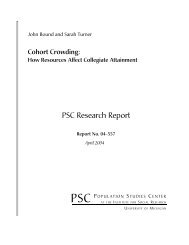Population Ageing and the Well-Being of Older Persons in Thailand ...
Population Ageing and the Well-Being of Older Persons in Thailand ...
Population Ageing and the Well-Being of Older Persons in Thailand ...
Create successful ePaper yourself
Turn your PDF publications into a flip-book with our unique Google optimized e-Paper software.
Section 6: Policy <strong>and</strong> Programme Responses<br />
referral system <strong>and</strong> covers <strong>in</strong>patient care at public or<br />
private facilities subject to a ceil<strong>in</strong>g for reimbursement<br />
<strong>in</strong> <strong>the</strong> case <strong>of</strong> private outlets.<br />
In recognition <strong>of</strong> <strong>the</strong> <strong>in</strong>creas<strong>in</strong>g dem<strong>and</strong> for quality<br />
health care provision for elderly, <strong>the</strong> M<strong>in</strong>istry <strong>of</strong><br />
Public Health established <strong>the</strong> Institute <strong>of</strong> Geriatric<br />
Medic<strong>in</strong>e <strong>in</strong> 1992. The Institute serves as a focal po<strong>in</strong>t<br />
to develop <strong>and</strong> transfer new knowledge <strong>and</strong><br />
technologies on gerontology as well as to develop new<br />
effective models <strong>of</strong> health care for older persons. By<br />
2007, all government hospitals have cl<strong>in</strong>ics to<br />
provide health services specifically for older persons.<br />
In addition, government hospitals are to have<br />
especially designated fast lanes for older persons<br />
us<strong>in</strong>g outpatient services <strong>and</strong> to have announcements<br />
<strong>and</strong> notices expla<strong>in</strong><strong>in</strong>g services that are readily<br />
underst<strong>and</strong>able to older persons.<br />
The M<strong>in</strong>istry <strong>of</strong> Public Health launched <strong>the</strong> Home<br />
Health Care Project <strong>in</strong> 2005 as a proactive health care<br />
service for <strong>the</strong> elderly at <strong>the</strong> community level. It is<br />
directed at older persons who are discharged from<br />
hospitals <strong>and</strong> need cont<strong>in</strong>u<strong>in</strong>g care at home or who<br />
are chronically ill or with disabilities <strong>and</strong> need<br />
monitor<strong>in</strong>g. As <strong>of</strong> 2006, <strong>the</strong> project was underway <strong>in</strong><br />
all regional central hospitals <strong>and</strong> prov<strong>in</strong>cial hospitals<br />
as well as 65 per cent <strong>of</strong> <strong>the</strong> community hospitals. In<br />
addition, several o<strong>the</strong>r projects exist to provide home<br />
<strong>and</strong> community health care <strong>in</strong>tegrated with social<br />
services e.g. <strong>the</strong> Bangkok 7 Model <strong>and</strong> <strong>the</strong><br />
Community Based Health Care <strong>and</strong> Social Services<br />
Model (MSDHS 2007).<br />
6.6 O<strong>the</strong>r social services <strong>and</strong> projects<br />
Homes for <strong>the</strong> aged. In l<strong>in</strong>e with <strong>the</strong> emphasis <strong>of</strong> <strong>the</strong><br />
family as ultimately responsible for elderly members,<br />
long term <strong>in</strong>stitutional residences for <strong>the</strong> aged are<br />
considered only as a last resort by <strong>the</strong> Thai<br />
government as a way <strong>of</strong> deal<strong>in</strong>g with elder care.<br />
Moreover, <strong>the</strong>re has traditionally been widespread<br />
aversion among <strong>the</strong> public to such long term care<br />
facilities (Knodel, Saengtienchai <strong>and</strong> Sittitrai 1995).<br />
Thus <strong>the</strong> number <strong>of</strong> government supported<br />
<strong>in</strong>stitutional homes for older persons is very small with<br />
only a few thous<strong>and</strong> residents. The first such home<br />
for <strong>the</strong> aged was set up <strong>in</strong> 1953 by <strong>the</strong> Department <strong>of</strong><br />
Public Welfare for older persons who are poor,<br />
homeless <strong>and</strong> have no one to care for <strong>the</strong>m. The<br />
number <strong>of</strong> homes under central government<br />
adm<strong>in</strong>istration exp<strong>and</strong>ed to 20 until 12 were recently<br />
transferred to local adm<strong>in</strong>istration organizations. In<br />
2006, <strong>the</strong> role <strong>of</strong> <strong>the</strong> eight that still operated by <strong>the</strong><br />
central government was exp<strong>and</strong>ed to provide day care<br />
services to nonresident older persons who stay with<br />
<strong>the</strong>ir families. To reflect this <strong>the</strong> homes are now called<br />
Social Welfare <strong>and</strong> Development Centres for <strong>the</strong><br />
Elderly. Also, four additional such centres were<br />
established br<strong>in</strong>g<strong>in</strong>g <strong>the</strong> total number to 12 such<br />
centres with an estimated 36,000 persons access<strong>in</strong>g<br />
services annually (MSDHS 2007). Several charitable<br />
organizations, mostly religious-related, also operate<br />
old-age homes.<br />
Social service centres. The Department <strong>of</strong> Social<br />
Welfare opened <strong>the</strong> first social service centre for<br />
elderly <strong>in</strong> 1979. At present <strong>the</strong>re are 19 such centres<br />
operated by <strong>the</strong> central <strong>and</strong> local government<br />
adm<strong>in</strong>istrations (National Commission <strong>of</strong> <strong>the</strong> Elderly<br />
2005). The centres provide <strong>in</strong>-house services <strong>and</strong><br />
emergency shelter for older persons. The <strong>in</strong>-house<br />
services provided <strong>in</strong>clude day-care, <strong>the</strong>rapeutic <strong>and</strong><br />
rehabilitation services, medical screen<strong>in</strong>g <strong>and</strong><br />
treatment, counsel<strong>in</strong>g, religious <strong>and</strong> recreation activities.<br />
Multi-Purpose Senior Citizen Centres. In 2006 a<br />
pilot project to establish Multi-Purpose Senior<br />
Citizen Centres was approved by <strong>the</strong> Bureau <strong>of</strong><br />
Empowerment for <strong>Older</strong> <strong>Persons</strong>. The project is<br />
<strong>in</strong>tended to <strong>in</strong>volve both <strong>the</strong> family <strong>and</strong> community<br />
<strong>in</strong> <strong>the</strong> activities <strong>of</strong> <strong>the</strong> centres <strong>and</strong> to encourage older<br />
persons to contribute <strong>and</strong> manage <strong>the</strong>ir own<br />
problems. Services are provided both at <strong>the</strong> centre<br />
<strong>and</strong> at home with <strong>the</strong> <strong>in</strong>tention to streng<strong>the</strong>n both<br />
<strong>the</strong> physical <strong>and</strong> mental well-be<strong>in</strong>g <strong>of</strong> older persons<br />
<strong>in</strong> <strong>the</strong> community. The project is be<strong>in</strong>g launched <strong>in</strong><br />
8 areas <strong>of</strong> <strong>the</strong> four regions <strong>and</strong> Bangkok (TGDRIF<br />
2007, MSDHS 2007)<br />
62















